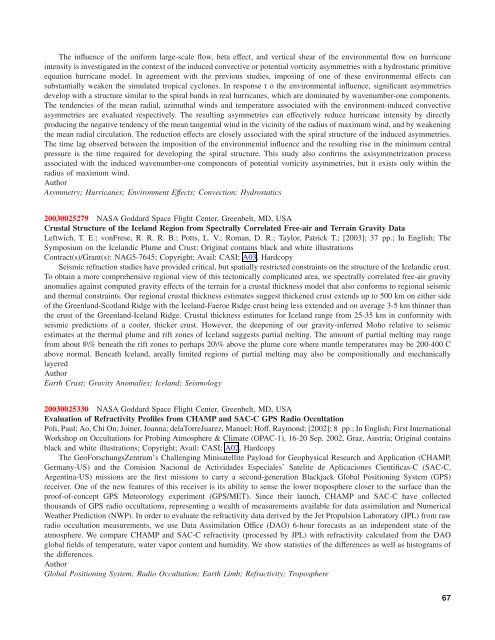Create successful ePaper yourself
Turn your PDF publications into a flip-book with our unique Google optimized e-Paper software.
The influence of the uniform large-scale flow, beta effect, and vertical shear of the environmental flow on hurricane<br />
intensity is investigated in the context of the induced convective or potential vorticity asymmetries with a hydrostatic primitive<br />
equation hurricane model. In agreement with the previous studies, imposing of one of these environmental effects can<br />
substantially weaken the simulated tropical cyclones. In response t o the environmental influence, significant asymmetries<br />
develop with a structure similar to the spiral bands in real hurricanes, which are dominated by wavenumber-one components.<br />
The tendencies of the mean radial, azimuthal winds and temperature associated with the environment-induced convective<br />
asymmetries are evaluated respectively. The resulting asymmetries can effectively reduce hurricane intensity by directly<br />
producing the negative tendency of the mean tangential wind in the vicinity of the radius of maximum wind, and by weakening<br />
the mean radial circulation. The reduction effects are closely associated with the spiral structure of the induced asymmetries.<br />
The time lag observed between the imposition of the environmental influence and the resulting rise in the minimum central<br />
pressure is the time required for developing the spiral structure. This study also confirms the axisymmetrization process<br />
associated with the induced wavenumber-one components of potential vorticity asymmetries, but it exists only within the<br />
radius of maximum wind.<br />
Author<br />
Asymmetry; Hurricanes; Environment Effects; Convection; Hydrostatics<br />
20030025279 NASA Goddard Space Flight Center, Greenbelt, MD, USA<br />
Crustal Structure of the Iceland Region from Spectrally Correlated Free-air and Terrain Gravity Data<br />
Leftwich, T. E.; vonFrese, R. R. R. B.; Potts, L. V.; Roman, D. R.; Taylor, Patrick T.; [2003]; 37 pp.; In English; The<br />
Symposium on the Icelandic Plume and Crust; Original contains black and white illustrations<br />
Contract(s)/Grant(s): NAG5-7645; Copyright; Avail: CASI; A03, Hardcopy<br />
Seismic refraction studies have provided critical, but spatially restricted constraints on the structure of the Icelandic crust.<br />
To obtain a more comprehensive regional view of this tectonically complicated area, we spectrally correlated free-air gravity<br />
anomalies against computed gravity effects of the terrain for a crustal thickness model that also conforms to regional seismic<br />
and thermal constraints. Our regional crustal thickness estimates suggest thickened crust extends up to 500 km on either side<br />
of the Greenland-Scotland Ridge with the Iceland-Faeroe Ridge crust being less extended and on average 3-5 km thinner than<br />
the crust of the Greenland-Iceland Ridge. Crustal thickness estimates for Iceland range from 25-35 km in conformity with<br />
seismic predictions of a cooler, thicker crust. However, the deepening of our gravity-inferred Moho relative to seismic<br />
estimates at the thermal plume and rift zones of Iceland suggests partial melting. The amount of partial melting may range<br />
from about 8\% beneath the rift zones to perhaps 20\% above the plume core where mantle temperatures may be 200-400 C<br />
above normal. Beneath Iceland, areally limited regions of partial melting may also be compositionally and mechanically<br />
layered<br />
Author<br />
Earth Crust; Gravity Anomalies; Iceland; Seismology<br />
20030025330 NASA Goddard Space Flight Center, Greenbelt, MD, USA<br />
Evaluation of Refractivity Pro<strong>file</strong>s from CHAMP and SAC-C GPS Radio Occultation<br />
Poli, Paul; Ao, Chi On; Joiner, Joanna; delaTorreJuarez, Manuel; Hoff, Raymond; [2002]; 8 pp.; In English; First International<br />
Workshop on Occultations for Probing Atmosphere & Climate (OPAC-1), 16-20 Sep. 2002, Graz, Austria; Original contains<br />
black and white illustrations; Copyright; Avail: CASI; A02, Hardcopy<br />
The GeoForschungsZentrum’s Challenging Minisatellite Payload for Geophysical Research and Application (CHAMP,<br />
Germany-US) and the Comision Nacional de Actividades Especiales’ Satelite de Aplicaciones Cientificas-C (SAC-C,<br />
Argentina-US) missions are the first missions to carry a second-generation Blackjack Global Positioning System (GPS)<br />
receiver. One of the new features of this receiver is its ability to sense the lower troposphere closer to the surface than the<br />
proof-of-concept GPS Meteorology experiment (GPS/MET). Since their launch, CHAMP and SAC-C have collected<br />
thousands of GPS radio occultations, representing a wealth of measurements available for data assimilation and Numerical<br />
Weather Prediction (NWP). In order to evaluate the refractivity data derived by the Jet Propulsion Laboratory (JPL) from raw<br />
radio occultation measurements, we use Data Assimilation Office (DAO) 6-hour forecasts as an independent state of the<br />
atmosphere. We compare CHAMP and SAC-C refractivity (processed by JPL) with refractivity calculated from the DAO<br />
global fields of temperature, water vapor content and humidity. We show statistics of the differences as well as histograms of<br />
the differences.<br />
Author<br />
Global Positioning System; Radio Occultation; Earth Limb; Refractivity; Troposphere<br />
67
















